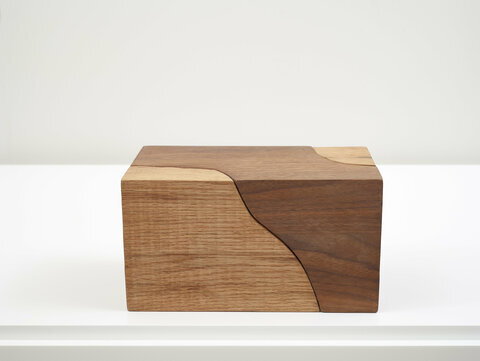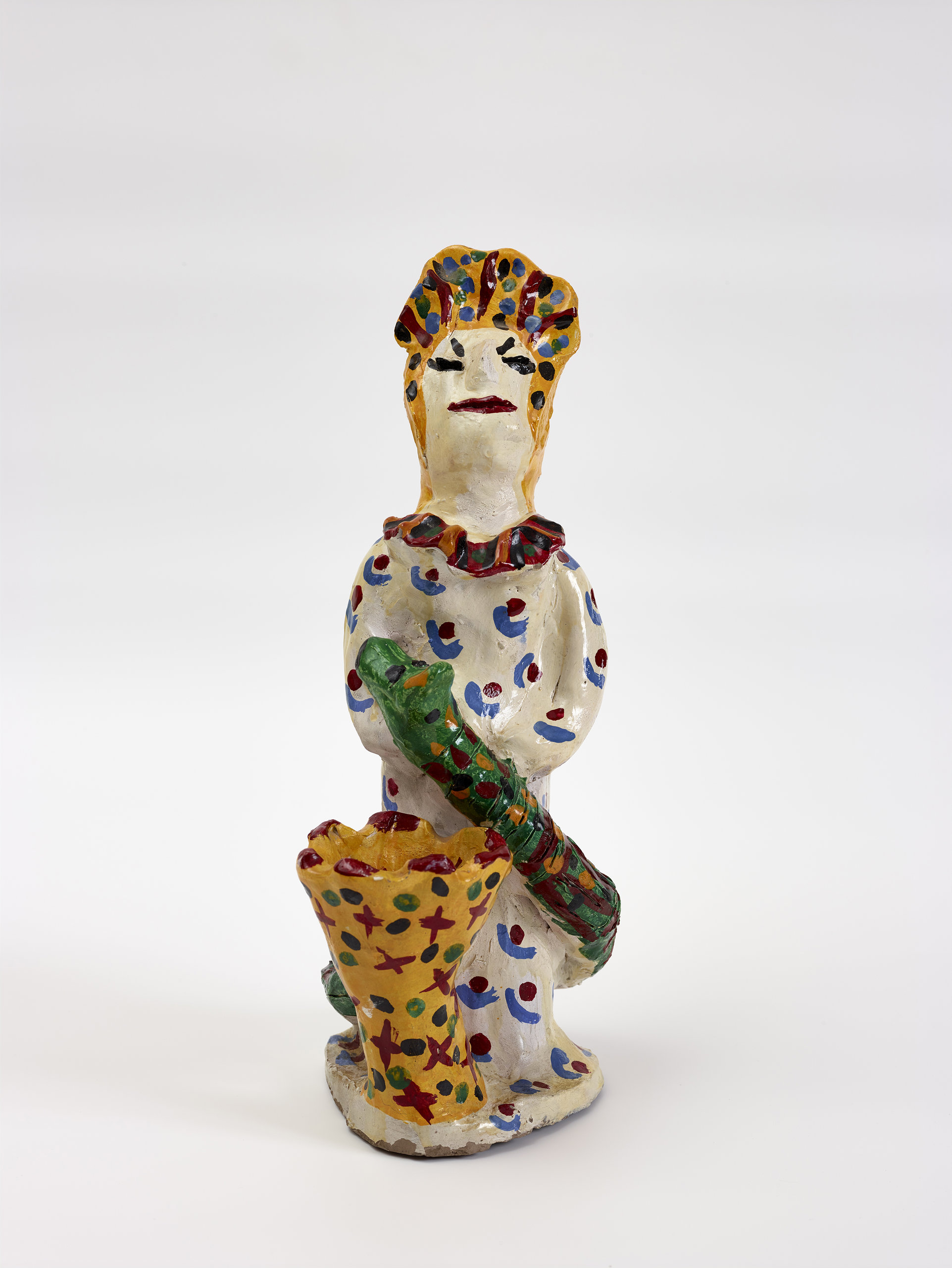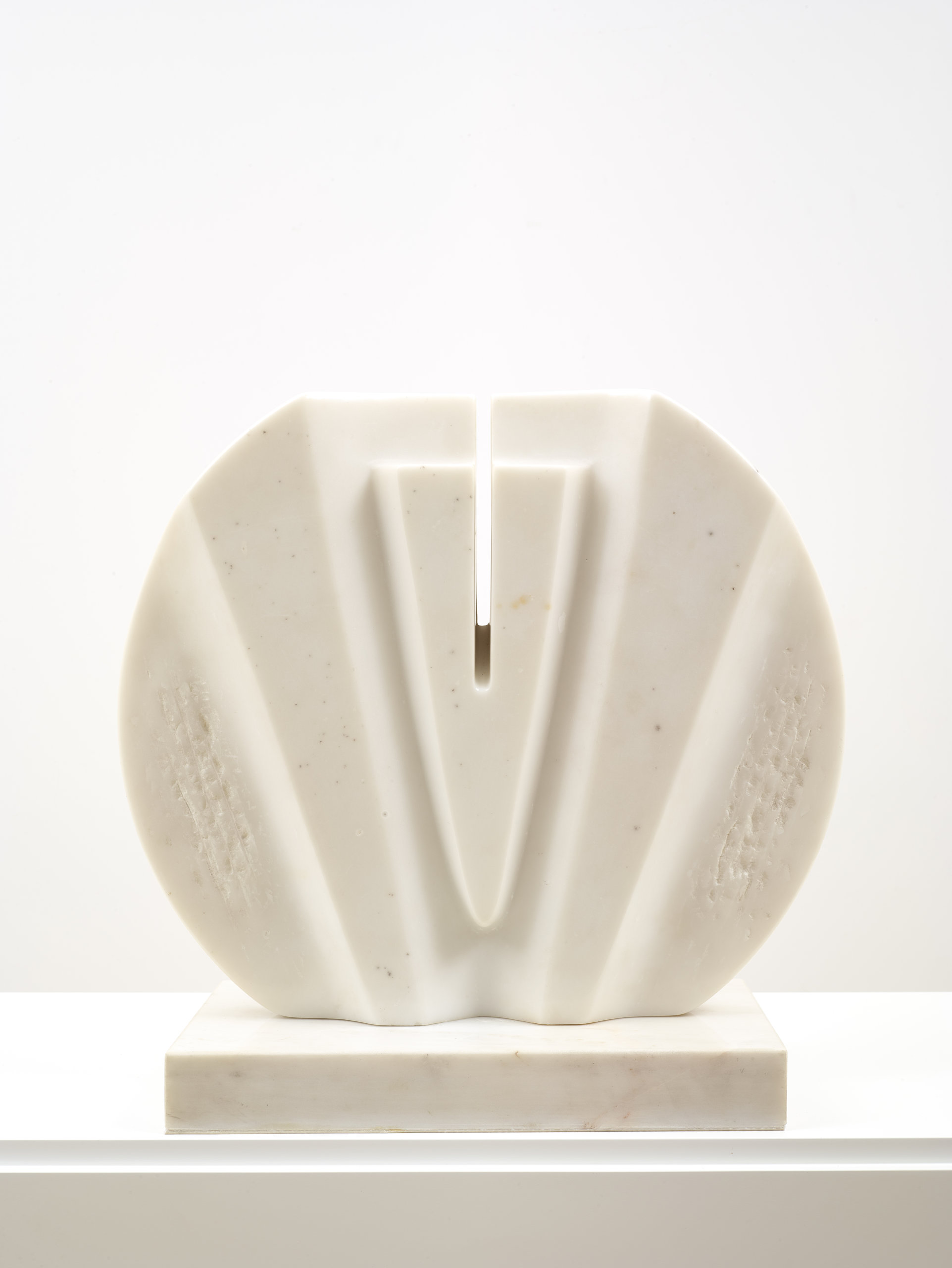Celebrating Women in Sculpture: Five Iconic Female Arab Artists
Sculpture is often thought of as the realm of men, but in the Arab world, female Arab artists have had a pivotal role to play in the introduction and evolution of the medium across the region. Here are six iconic female artists who have profoundly contributed to the evolution of Arab art, each with her own approach, sensibility, and style.
1. Saloua Raouda Choucair (1916 – 2017)

Saloua Raouda Choucair, born in 1916, is referred to as the inventor of abstract art in Lebanon. She championed abstraction as a primary mode of artistic expression, and was a pioneer of modular geometric abstraction. Choucair’s experimentations with sculpture show the multitude of inspirations from which she drew upon: Islamic art Arabesque, cubism, Sufism, poetry, and mathematics, to name a few.
In one of the artworks that is part of the DAF collection, Choucair would explore the theme of duality, based on the notion of separation and unity: the sculpture Dual, 1983, is made of two pieces of wood, which can interlock to create a box that can also detach as two separate pieces. This artwork conceptually expressed the artist’s hopes for the city of Beirut to become reunited again in the wake of the Lebanese Civil War.Saloua Raouda Choucair passed away in 2017, but her legacy lives on with the newly opened Saloua Raouda Choucair Museum, in Ras El Metn, Mount Lebanon.
2. Baya (1931 – 1998)

Algerian artist Baya Mehieddine, born Fatima Haddad in 1931, is known simply as the iconic Baya. After losing both her parents at the age of five, Baya lived with her grandmother until she was eleven. She would then work as a live-in servant for a Frenchwoman named Marguerite Caminat, who saw and encouraged Baya’s artistic curiosity. At the age of sixteen, Baya’s talents would draw the attention of a French art dealer, after which she was invited to exhibit her work in his gallery in Paris, where she came in contact with artists such as Braque, Matisse, and Picasso. Baya’s style is inspired primarily by the traditions and creation of her Kabyle community (the Berbers of the mountainous regions of northeast Algeria). Traditionally, the women in these societies created the various objects used in daily life, and decorated them with elaborate patterns and geometric shapes. Baya utilized these same motifs – the gardens, colors, and ceramic – by drawing upon her community’s visual culture.
3. Mona Saudi (1945 – 2022)
-MonaSaudi-Front-(2)-copy.jpg)

Mona Saudi, known as a pioneer of Jordanian art, was born in 1945 in Amman, and grew up in a religious and strict household. She was forced to drop out of school and was forbidden by her father from applying to university. But, being a rebellious dreamer from her youth, in 1963, at the age of seventeen, Saudi would run away from her home and travel to Beirut, the cosmopolitan and bustling cultural capital of Lebanon, to pursue her dreams.
During her time in Beirut, Saudi would learn from and make lifelong friendships with artists such as Paul Guiragossian, Youssef Al Khal, Adonis, and was mentored by renowned sculptor Michel Basbous. She would then make her way to Paris, and begin her study of sculpture at l’Ecole Nationale Superieure des Beaux-Arts. Saudi’s sculptures are guided by three main aspects, as reflected in her worksTree of Life, and Birth of Beirut, both part of the DAF collection: the first was the influence of Romanian artist Constantin Brancusi (1876 – 1957), whose approach to sculpture prioritized the essence of an idea, a perspective that is often invoked by Saudi in her artworks. The second was the choice of material that she used for her sculptures – stone, and particularly, those that are local to the region echoing the textures and colors of her own Arab environment. The third was how she manipulated the hard stone to bring out a curvaceous and warm quality that became a hallmark of her style.Saudi’s life and her works exemplified a true artist’s calling. Not one to follow trends, her artistic journey was one of constant personal growth and evolution, and Saudi remained, as she ever was, a dreamer and a rebel till the end.
4. Shaikha al Mazrou (1988 - )
-Front-2-web.jpg)
Born 1988 in the United Arab Emirates, contemporary Emirati artist, Shaikha Al Mazrou’s art practice focuses on the exploration of materiality. Her sculptures often look into the ways in which materials behave. This is best exemplified by her paper sculpture series, one of which is part of DAF’s collection. The concept for this series originally began with simple A4 papers, which Al Mazrou then folded carefully into specific geometric shapes. After that, she recreated these same shapes from their A4 paper prototypes, with all their folds, crevices, and creases into large steel sculptures that reproduced the tension and tactility of the material. Al Mazrou’s works are in a continuous and evolving conversation with other minimalist art movements that are similarly preoccupied with the formal qualities of materiality. Her experimentations focus on the ways in which objects exist within space, which she investigates by re-creating them as abstract large-scale geometric sculptures and installations. One of her largest works to date, Red Stack, 2022, was presented in Regent’s Part, London, and she has several permanent public artworks, such as the two-part resin sculpture When Mountains are Domesticated, 2022, commissioned for AIUIa International Airport, KSA, and The Plinth, 2021, which was one of the works commissioned for Expo 2020 Dubai. Al Mazrou is currently an Assistant Arts Professor of Visual Arts at the New York University Abu Dhabi.
5.Mona Hatoum (1952 - )

Palestinian artist Mona Hatoum was born 1952 in Beirut, Lebanon to refugees of the 1948 Nakba. She would then move with her family to London where she would complete her art education. Her early works in the 1980s were distinctly political and evocative as they explored the violence and aggression of displacement and conflict upon the body and engaged with the realities of the brutality war and absence of agency.By the 1990s, her artwork would move towards themes of exile and nomadism by focusing on everyday objects such as domestic tools and kitchenware and turning their banality into sites of instability and disorientation. The sculpture Witness, 2009, currently part of DAF’s collection, is a miniature ceramic replica of the Martyr’s Monument, 1960, in Downtown Beirut. The original sculpture was commissioned from Italian sculptor Marino Mazzaacurati in 1960, in honor of Lebanese patriots who were executed by the Ottomans in 1916. It suffered great damage during the Lebanese Civil War (1975-1990), but was then restored while preserving the bullet holes that marred it as a lasting testament to the violence.
Hatoum shrunk this public monument, keeping the bullet holes, which are further emphasized by their contrast to the ceramic white. By bringing down the scale of the statue, Hatoum is breaking the boundaries between what is considered public vs private, and questioning the role of war monuments across the social and individual spheres. Her work confronts the political and social issues broiling at the time, while simultaneously bringing in the private into the conversation.
These five female Arab artists have profoundly influenced the evolution of Arab art both within their context and internationally as well. Their approach to their practice and work extends across various themes, concepts, and tools as they engage with and shape perspectives about art, both at the local and global scale.



Comments on Celebrating Women in Sculpture: 5 Iconic Female Arab Artists